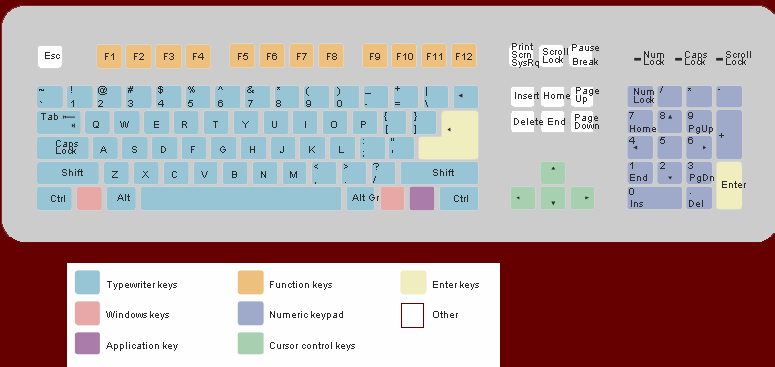|
Commonly known as "function keys", F1 through F12 may have a
variety of different uses or no use at all. Depending on the installed
operating system and the software program currently open will change
how each of these keys operate. A program is capable of not only using
each of the function keys, but also combining the function keys with
the ALT
and/or CTRL
keys, for example, Microsoft Windows users can press ALT + F4 to close
the program currently active.
Below is a short-listing of some of the common functions of
the functions keys on computers running Microsoft Windows. As mentioned
above not all programs support function keys and/or may perform
different tasks then those mentioned below. If you are looking for more
specific shortcut keys and function key examples we suggest seeing our shortcut key page.
F1
- Almost always used as the help key, almost every program
will open the help screen when this key is pressed.
- Windows
Key + F1 would open the Microsoft Windows help and support center.
- Open the Task Pane.
F2
- In Windows commonly used to rename a highlighted icon or
file.
- Alt + Ctrl + F2 opens a new document in Microsoft Word.
- Ctrl + F2 displays the print preview window in Microsoft
Word.
F3
- Often opens a search feature for many programs including
Microsoft Windows.
- Shift + F3 will change the text in Microsoft Word from
upper to lower case or a capital letter at the beginning of every word.
F4
- Open find window.
- Repeat the last action performed (Word 2000+)
- Alt + F4 will close the program currently active in
Microsoft Windows.
- Ctrl + F4 will close the open window within the current
active window in Microsoft Windows.
F5
- In all modern Internet
browsers pressing F5 will refresh
or reload the page or document window.
- Open the find, replace, and go to window in Microsoft Word.
- Starts a slideshow in PowerPoint.
F6
F7
- Commonly used to spell check and grammar check a document
in Microsoft programs such as Microsoft Word, Outlook, etc.
- Shift + F7 runs a Thesaurus check on the word highlighted.
- Turns on Caret browsing in Mozilla Firefox.
F8
- Function key used to enter the Windows startup menu,
commonly use to get into Windows safe mode.
F9
- Opens the Measurements toolbar in Quark 5.0.
F10
- In Microsoft Windows activates the menu bar
of an open application.
- Shift + F10 is the same as right-clicking
on a highlighted icon, file, or Internet link.
F11
- Full-screen mode in all modern Internet browsers.
F12
- Open the Save as window in Microsoft Word.
- Shift + F12 save the Microsoft Word document.
- Ctrl + Shift + F12 prints a document in Microsoft Word.
|

 Windows Key
Windows Key